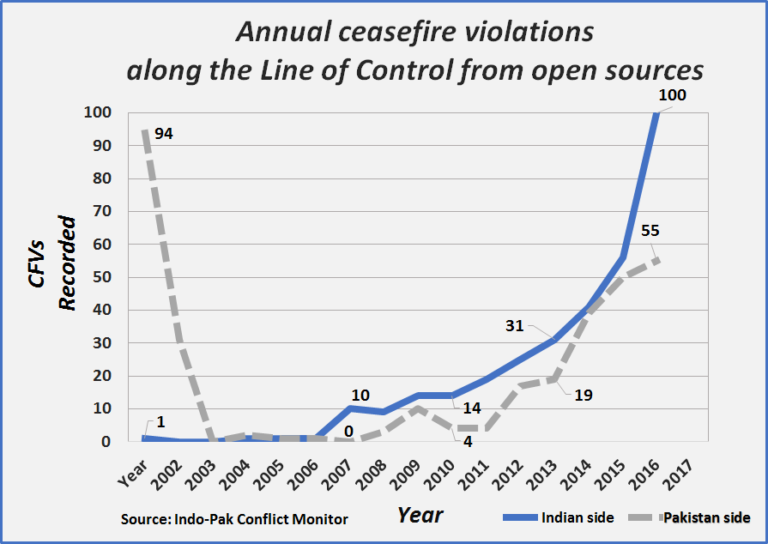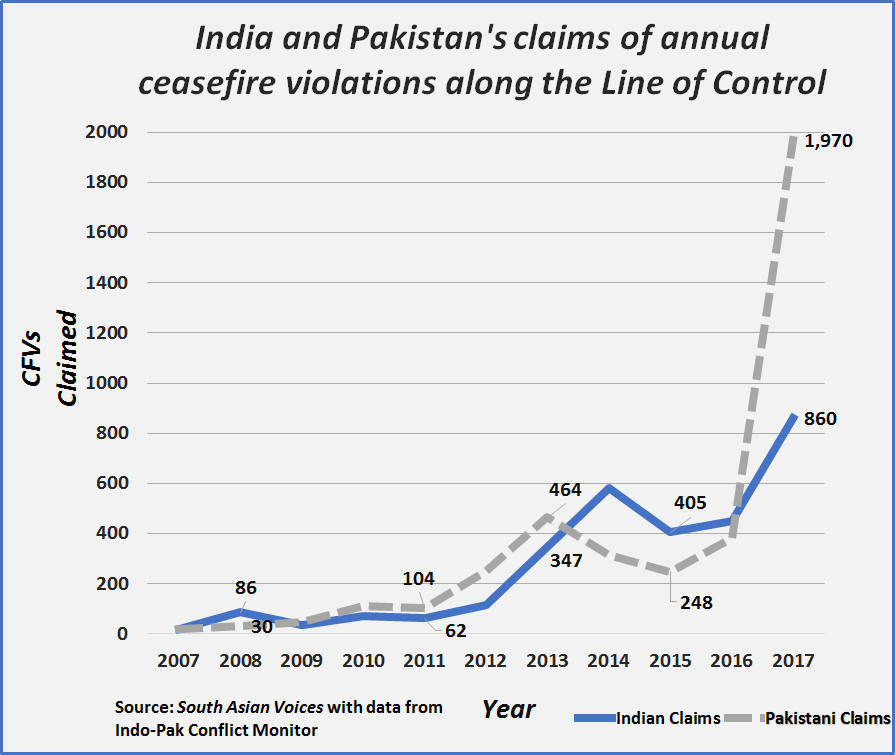Quotes of the week:
“For Pakistan, the present situation is favorable because at a very minimal cost, it is achieving good dividends in Kashmir. India is profusely bleeding both in terms of war casualties as well as losses of its material resources. It is very unlikely that India would continue to bear such a high cost of confrontation for much too long.” — Pakistan’s former Army Chief Aslam Beg, 2000
“The proper response would be a declaratory policy that deliberate infringement of the sanctity of the Line of Control and wanton cross-border terrorism in furtherance of proxy war will meet with prompt retaliation in a manner, time and place of India’s choosing.” — Kargil Review Commission Report chaired by K. Subramanyam, 2000
While you were accentuating worry lines over Donald Trump’s impending decision on the Iran nuclear deal, his unscriptable and as yet unscheduled encounter with Kim Jong Un, his hiring of savants appearing on Fox’s airwaves, and Vladimir Putin’s replay of the Soviet Union’s worst habits, you might not have noticed that violence between India and Pakistan along the Kashmir divide is on a serious upswing.
The following graphs prepared by my Stimson colleague Emily Tallo tell the tale. The first is drawn from the research of Dr. Happymon Jacob who teaches courses on diplomacy and disarmament at the School of International Studies at Jawaharlal Nehru University in New Delhi. Happymon is completing a book on this subject, Line on Fire: Ceasefire Violations and India-Pakistan Escalation Dynamics. For more of his work, check out his website and his report for the U.S. Institute of Peace.The above graph depicts cease-fire violations as reported in open sources. The graph below covers a shorter period of time and reflects official estimates released by the Governments of India and Pakistan. Pakistan’s estimates are noticeably higher than those of India.

The above graph depicts cease-fire violations as reported in open sources. The graph below covers a shorter period of time and reflects official estimates released by the Governments of India and Pakistan. Pakistan’s estimates are noticeably higher than those of India.

Like everything else relating to disputes between Pakistan and India, there is disagreement about the number of cease-fire violations instigated by the other side. Open sources are not conclusive in this regard, as press reports are dependent on military and government sources. They also undercount actual fire-fights – but by how much outsiders cannot determine.
Pakistan’s number of Indian cease-fire violations seems seriously inflated, at least in comparison to the official Indian count of Pakistani violations. Violence along the Kashmir divide is choreographed and ritualized. Retaliation is de rigueur, at the time of the violation or later, which strongly suggests that whatever the correct numbers are, they bear some resemblance to each other.
The Big Picture reflected in these graphs is not comforting: Whatever the exact data are, it is clear that the level of violence across the Kashmir divide is rising significantly. The ceasefire arranged in 2003 by Pervez Musharraf and A.B. Vajpayee (after the extended “Twin Peaks” crisis sparked by an attack on the Indian Parliament building) held up well through 2007. Then fire fights began a steady climb upward that shows no signs of peaking. The way things are going, it looks like 2018 will be a banner year for cease-fire violations.
Absent political intervention, violence can continue to rise along the Kashmir divide, in which case the likelihood of serious clashes with escalatory potential will also rise. Alternatively, political leaders can quietly or publically orchestrate a mutual climb-down. If so, the initiative will likely have to come from India, which has a confident Prime Minister, rather than Pakistan, which has a Prime Minister sitting in for Nawaz Sharif, who has stepped down after running afoul of the courts, with an assist from the military establishment.
Michael Krepon is the Co-founder of the Stimson Center. This piece originally ran in Arms Control Wonk on March 21, 2018.

India-Pakistan Friction Heats Up
By Michael Krepon
In South Asia
Quotes of the week:
While you were accentuating worry lines over Donald Trump’s impending decision on the Iran nuclear deal, his unscriptable and as yet unscheduled encounter with Kim Jong Un, his hiring of savants appearing on Fox’s airwaves, and Vladimir Putin’s replay of the Soviet Union’s worst habits, you might not have noticed that violence between India and Pakistan along the Kashmir divide is on a serious upswing.
The following graphs prepared by my Stimson colleague Emily Tallo tell the tale. The first is drawn from the research of Dr. Happymon Jacob who teaches courses on diplomacy and disarmament at the School of International Studies at Jawaharlal Nehru University in New Delhi. Happymon is completing a book on this subject, Line on Fire: Ceasefire Violations and India-Pakistan Escalation Dynamics. For more of his work, check out his website and his report for the U.S. Institute of Peace.The above graph depicts cease-fire violations as reported in open sources. The graph below covers a shorter period of time and reflects official estimates released by the Governments of India and Pakistan. Pakistan’s estimates are noticeably higher than those of India.
The above graph depicts cease-fire violations as reported in open sources. The graph below covers a shorter period of time and reflects official estimates released by the Governments of India and Pakistan. Pakistan’s estimates are noticeably higher than those of India.
Like everything else relating to disputes between Pakistan and India, there is disagreement about the number of cease-fire violations instigated by the other side. Open sources are not conclusive in this regard, as press reports are dependent on military and government sources. They also undercount actual fire-fights – but by how much outsiders cannot determine.
Pakistan’s number of Indian cease-fire violations seems seriously inflated, at least in comparison to the official Indian count of Pakistani violations. Violence along the Kashmir divide is choreographed and ritualized. Retaliation is de rigueur, at the time of the violation or later, which strongly suggests that whatever the correct numbers are, they bear some resemblance to each other.
The Big Picture reflected in these graphs is not comforting: Whatever the exact data are, it is clear that the level of violence across the Kashmir divide is rising significantly. The ceasefire arranged in 2003 by Pervez Musharraf and A.B. Vajpayee (after the extended “Twin Peaks” crisis sparked by an attack on the Indian Parliament building) held up well through 2007. Then fire fights began a steady climb upward that shows no signs of peaking. The way things are going, it looks like 2018 will be a banner year for cease-fire violations.
Absent political intervention, violence can continue to rise along the Kashmir divide, in which case the likelihood of serious clashes with escalatory potential will also rise. Alternatively, political leaders can quietly or publically orchestrate a mutual climb-down. If so, the initiative will likely have to come from India, which has a confident Prime Minister, rather than Pakistan, which has a Prime Minister sitting in for Nawaz Sharif, who has stepped down after running afoul of the courts, with an assist from the military establishment.
Michael Krepon is the Co-founder of the Stimson Center. This piece originally ran in Arms Control Wonk on March 21, 2018.